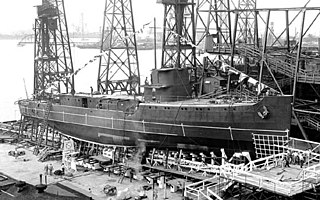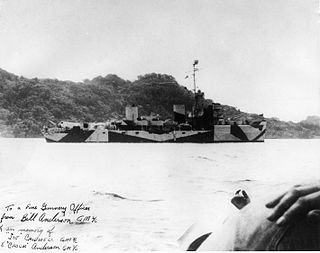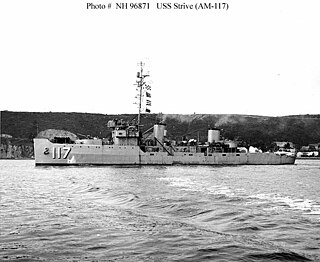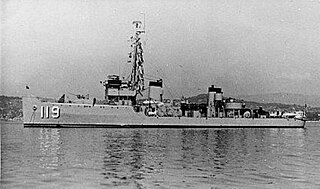
USS Devastator (AM-318) was an Auk-class minesweeper acquired by the U.S. Navy for the dangerous task of removing naval mines from minefields laid in the water to prevent ships from passing.

USS Auk (AM-57) was an Auk-class minesweeper acquired by the United States Navy for the dangerous task of removing mines from minefields laid in the water to prevent ships from passing.
USS Dextrous (AM-341) was an Auk-class minesweeper built for the United States Navy which served in World War II, the Korean War, and beyond. She was later transferred to the Republic of Korea Navy where she served as ROKS Koje (PCE-1003).
USS Swift (AM-122) was an Auk-class minesweeper acquired by the United States Navy for the dangerous task of removing mines from minefields laid in the water to prevent ships from passing.

USS Waxwing (AM-389) was an Auk-class minesweeper acquired by the United States Navy for the dangerous task of removing mines from minefields laid in the water to prevent ships from passing. She was the only U.S. Navy ship named for the waxwing, any of several American and Asiatic songbirds which are for the most part brown and are characterized by predominant crests and velvety plumage.
USS Pilot (AM-104) was a United States Navy Auk-class minesweeper that saw service in the Mediterranean and Pacific Theaters of Operations during World War II.

USS Velocity (AM-128) was an Auk-class minesweeper acquired by the United States Navy for the dangerous task of removing mines from minefields laid in the water to prevent ships from passing. She was the second warship to bear the name.

The third USS Champion (BAM-1/AM-314/MSF-314) was an Auk-class minesweeper of the United States Navy.

USS Staff (AM-114) was an Auk-class minesweeper acquired by the United States Navy for the dangerous task of removing mines from minefields laid in the water to prevent ships from passing.

USS Strive (AM-117) was an Auk-class minesweeper acquired by the United States Navy for the dangerous task of removing mines from minefields laid in the water to prevent ships from passing.

USS Steady (AM-118) was an Auk-class minesweeper acquired by the United States Navy for the dangerous task of removing mines from minefields laid in the water to prevent ships from passing.

USS Sustain (AM-119) was an Auk-class minesweeper acquired by the United States Navy for the dangerous task of removing mines from minefields laid in the water to prevent ships from passing.
USS Sway (AM-120) was an Auk-class minesweeper acquired by the United States Navy for the dangerous task of removing mines from minefields laid in the water to prevent ships from passing.
USS Facility (AM-233) was an Admirable-class minesweeper built for the United States Navy during World War II. The ship was ordered and laid down as PCE-905-class patrol craft USS PCE-906 but was renamed and reclassified before her June 1944 launch as Facility (AM-233). After earning three battle stars for service in the Pacific during World War II, she was decommissioned in September 1946 and placed in reserve. While in reserve, Facility was reclassified as MSF-233 in February 1955 but never reactivated. In October 1962, she was sold to the Mexican Navy and renamed ARM DM-04. Her ultimate fate is not reported in secondary sources; she may have been out of service by April 1973 when another member of the Admirable class was acquired by the Mexican Navy and given the name DM-04.
USS Superior (AM-311) was a steel-hulled Admirable-class minesweeper built for the U.S. Navy in 1944. Superior participated in the final struggle in the Pacific Ocean against the Empire of Japan during the end of World War II and remained behind, after the war ended, to clear minefields laid during the war.
USS Strategy (AM-308) was a steel-hulled Admirable-class minesweeper built for the U.S. Navy during World War II. She had a courageous and adventurous life in clearing minefields in areas controlled by Japanese forces. She survived attacks by Japanese gunfire and planes, and won four battle stars for her service under battle conditions.
USS Scurry (AM-304) was a steel-hulled Admirable-class minesweeper constructed for the U.S. Navy during World War II. She was crewed by sailors who were trained in minesweeping, and quickly sent to the Pacific Ocean to clear minefields so that Allied forces could invade Japanese-held beaches. For this dangerous work, often under enemy fire, she was awarded four battle stars.
USS Device (AM-220) was an Admirable-class minesweeper built for the United States Navy during World War II. She was awarded three battle stars for service in the Pacific during World War II. She was decommissioned in August 1946 and placed in reserve. Although she did not see service in the war zone, Device was recommissioned in March 1950 during the Korean War and remained in commission until February 1954, when she was placed in reserve again. While she remained in reserve, Device was reclassified as MSF-220 in February 1955 but never reactivated. In October 1962, she was sold to the Mexican Navy and renamed ARM DM-11. In 1994 she was renamed ARM Cadete Agustín Melgar (C54), spelled Augustín Melgar in some sources. She was stricken in 2000, and scuttled for use as an artificial reef in Bahía de Loreto National Park.
USS Knave (AM-256) was an Admirable-class minesweeper built for the United States Navy during World War II. She served in the Atlantic during World War II and was decommissioned in May 1946 and placed in reserve. While she remained in reserve, Knave was reclassified as MSF-256 in February 1955 but never reactivated. In October 1962, she was sold to the Mexican Navy and renamed ARM DM-13. In 1994 she was renamed ARM Cadete Juan Escutia (C56). She was stricken in 2000, but her ultimate fate is not reported in secondary sources.
USS Skirmish (AM-303) was an Admirable-class minesweeper built for the United States Navy during World War II. She received four battle stars during World War II. She was decommissioned in December 1945 and placed in reserve. In February 1955, while still in reserve, her hull number was changed from AM-303 to MSF-303, but she was not reactivated. She was transferred to the Dominican Republic in January 1965 and renamed Separación (BM455). She was employed as a patrol vessel in Dominican Navy service and renamed Prestol Botello in 1976. Her pennant number was changed from BM454 to C454 during a 1995 refit. As of 2007, Prestol Botello remained in active service for the Dominican Navy.








